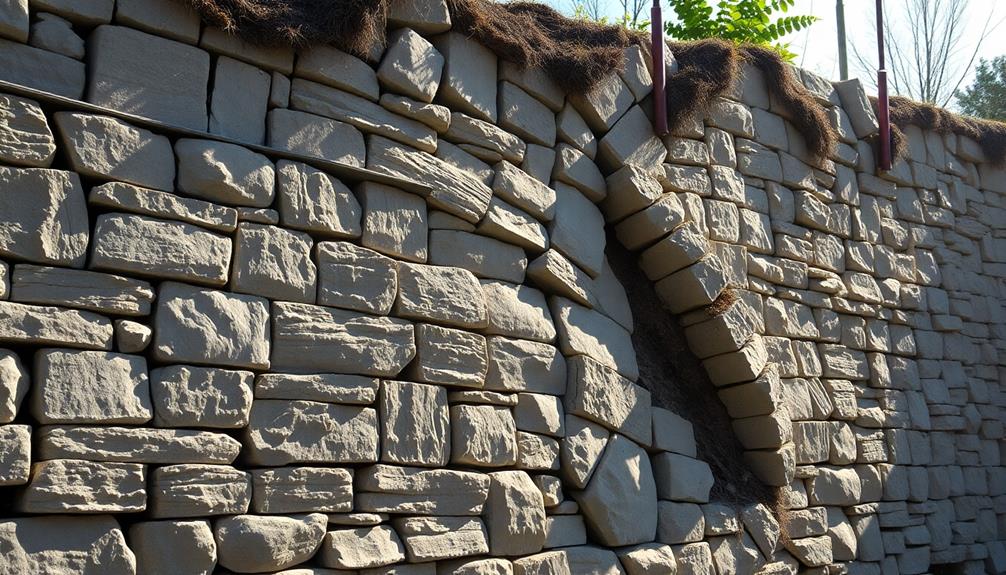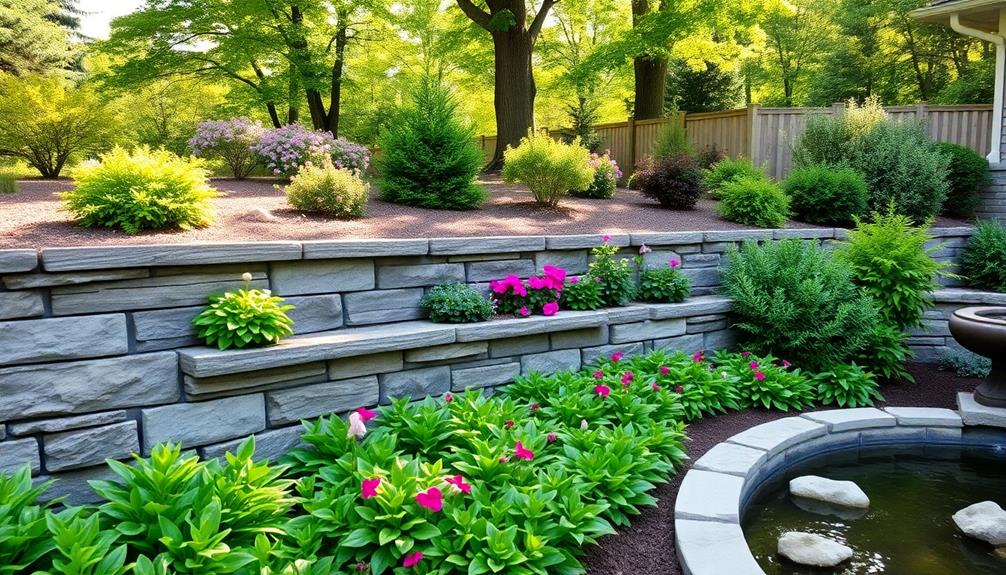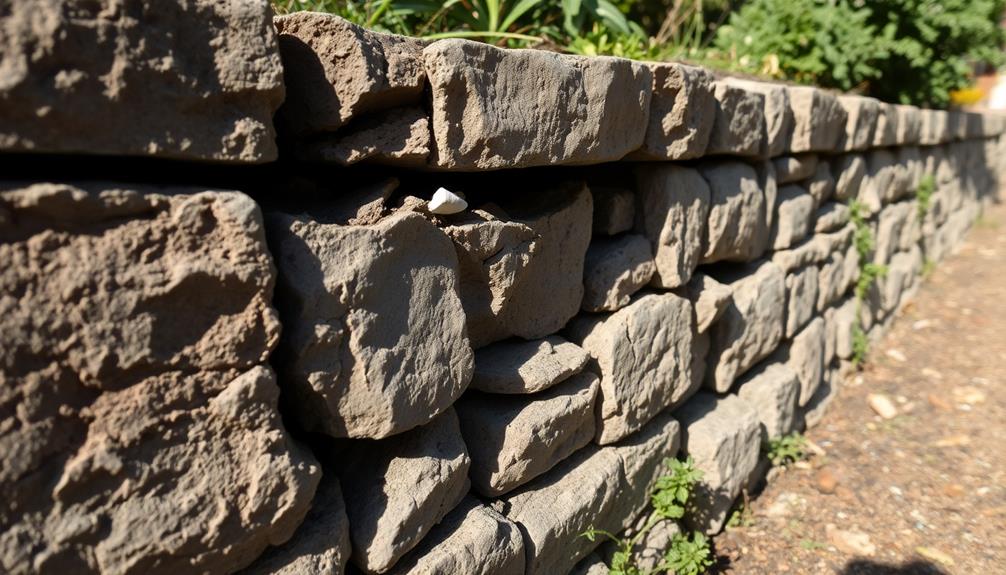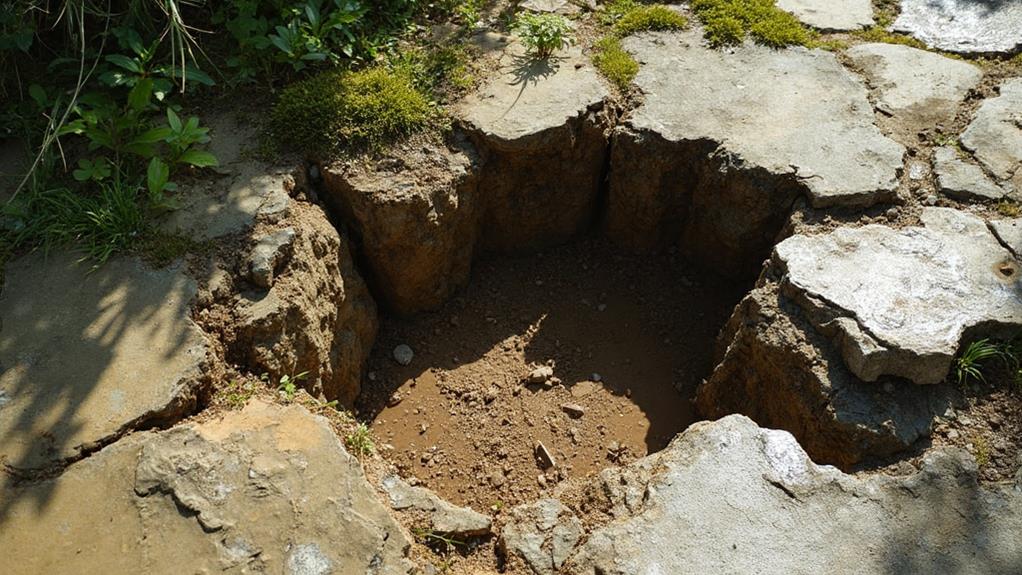Ten critical signs indicating your retaining wall may need repair include leaning, visible cracks, water infiltration, misalignment, bulging, soil erosion under the base, poor drainage, deterioration from freeze-thaw cycles, efflorescence indicating moisture presence, and sagging or uneven capstones. These issues are often interrelated, where structural deformities like leaning or bulging may compromise stability, while water damage through infiltrated cracks exacerbates foundational weaknesses. Addressing such symptoms promptly through inspection and varied repair techniques, like patching, sealing, reinforcement, and drainage management, is essential for maintaining your wall's integrity. By continuing to explore these elements, you'll understand the necessary steps to protect your property.
Table of Contents
ToggleWalls Contractor Highlights
- Cracks appearing on the surface may indicate serious structural issues.
- Bulging or leaning sections could threaten the wall's stability.
- Water pooling or moisture marks suggest drainage problems.
- Gaps forming between blocks can imply foundation shifts.
- Chunks or pieces falling off point to material deterioration.
Leaning Retaining Wall

A leaning retaining wall can stem from various causes, including inadequate drainage, poor construction techniques, or natural soil erosion, each potentially compromising the wall's structural integrity. This compromise not only affects the wall's appearance but also poses risks to the safety of adjacent structures and landscapes.
Companies like Granite Company, with their emphasis on building long-lasting and aesthetically pleasing walls, recognize the importance of tackling these issues promptly. Addressing the issue necessitates a thorough strategy encompassing timely repair, reinforcement solutions, and preventive measures to guarantee the long-term reliability and performance of the retaining wall.
Causes of Wall Leaning
Various factors contribute to the leaning of retaining walls, often stemming from issues related to construction, environment, or maintenance. Inadequate engineering during the construction phase can result in walls being unable to withstand lateral earth pressures. Over time, walls initially built without proper drainage solutions may absorb water, increasing pressure and prompting them to tilt. The choice of materials also plays a crucial role; inferior or inappropriate materials can degrade faster under stress, hastening the leaning process.
Environmental conditions are another contributor to this structural issue. Seasonal changes bring cycles of freezing and thawing, expanding soil that exerts uneven forces on walls. Landscapes with poor soil composition, particularly those rich in clay, aggravate this by swelling considerably when wet, while shrinking upon drying. Moreover, vegetation near retaining walls can have detrimental effects; tree roots invading the wall structure can slowly pry it apart, while excessive plant growth adds unnecessary weight.
Neglecting regular maintenance can allow emerging issues to worsen unnoticed. A lack of inspections means small cracks, often precursors to major structural problems, remain unchecked. Without routine intervention, these minor blemishes gradually morph into more severe integrity concerns. Through understanding and addressing these causative factors, leaning can be prevented or mitigated.
Impact on Structural Stability
The structural stability of a retaining wall is fundamentally compromised when it begins to lean, posing significant risks both to property and personal safety. This condition signals underlying issues that can lead to catastrophic failure if not addressed. As a result, understanding how a leaning wall affects stability is indispensable for those concerned with maintaining the integrity and safety of their property. A leaning wall not only degrades the aesthetic value of a landscape but also undermines confidence in the safety of adjacent structures.
Listed below are several critical impacts of a leaning retaining wall on structural stability:
- Load Redistribution: A leaning wall shifts loads unevenly, increasing stress on certain areas, which can exacerbate existing weaknesses or create new points of failure.
- Soil Erosion: The wall's tilt may allow water infiltration, leading to soil erosion behind the wall, further destabilizing the structure and the landscape it safeguards.
- Foundation Integrity: The foundational support of both the wall and nearby structures can be jeopardized, leading to subsidence or fissures that may affect the structure's overall stability.
Awareness and timely intervention are key, as a seamless community effort in identifying and addressing such issues can prevent hazardous outcomes and guarantee continued security for all stakeholders.
Repair and Prevention Strategies
To effectively address the challenges posed by a leaning retaining wall, implementing robust repair and prevention strategies is essential. A careful assessment of the wall's current condition forms the foundation of an effective response plan.
Corrective measures begin with evaluating drainage systems, as poor water management often exacerbates wall instability. Ensuring adequate drainage can alleviate pressure, reducing the risk of further leaning.
Stabilization techniques, such as installing tiebacks or anchors, are commonly employed to correct and support a leaning wall. These systems provide additional structural support by binding the wall to a stable substrate, thereby mitigating the forces causing destabilization. Another effective method involves reinforcing the existing wall through the application of carbon fiber or steel reinforcements, which enhances both strength and stability.
Proactively preventing future issues often involves the construction of proper drainage systems, including French drains or retaining wall weep holes, to manage water flow efficiently. Additionally, maintaining vegetation around the wall can help control erosion and soil displacement, further supporting structural integrity. Collaborating with experienced professionals offers peace of mind, fostering a sense of community involvement and shared responsibility in preserving the integrity of retaining walls.
Benefits

Repairing a retaining wall offers numerous advantages by safeguarding against further structural damage and enhancing the overall stability of the property. For instance, by using boulder retaining walls, you can achieve a durable and natural look that complements various landscape styles.
Prevents Further Damage
Addressing a retaining wall repair promptly serves as a critical measure to guarantee further structural damage and deterioration. Left unchecked, even minor issues can escalate, jeopardizing not only the wall's integrity but also the surrounding landscape and properties. A well-maintained retaining wall acts as a robust barrier, safeguarding against the detrimental effects of soil erosion, water damage, and pressure from the earth it retains. By addressing these repairs, homeowners join a community of individuals committed to preserving the longevity and safety of their investments.
Timely intervention offers several advantages, such as:
- Avoiding Costly Repairs: Early action can prevent the need for extensive and expensive reconstruction, maintaining manageable repair costs.
- Preserving Aesthetic Appeal: Proper maintenance guarantees the wall remains an attractive feature, contributing to an overall sense of unity and belonging within the neighborhood.
- Preventing Soil Erosion: Quick repairs halt soil displacement, which otherwise can lead to landscape alterations and foundation instability of nearby structures.
Furthermore, proactive repair instills peace of mind, as homeowners can be confident in the stability and reliability of their retaining walls. This diligence not only guarantees the family's safety but also upholds the community's collective standard of care and pride.
Enhances Property Stability
A structurally sound retaining wall is essential for enhancing property stability, guaranteeing that the land it supports remains intact and secure. This foundation of stability is crucial in areas with varying topography or properties that experience water runoff, erosion, or land movement.
A well-maintained retaining wall serves as a robust barricade, preventing soil displacement while safeguarding essential property features, such as gardens, patios, and even building foundations, from potential geological disturbances. For those seeking continuity and safety, understanding the role of a retaining wall in maintaining the equilibrium of their property is indispensable.
When a retaining wall starts deteriorating, the stability of the surrounding property is threatened, leading to possible costly repairs and structural damage. Consequently, recognizing early warning signs allows property owners to initiate timely repairs that restore the wall's integrity and utility.
This preemptive action not only stabilizes the immediate landscape but also reinforces the broader community's infrastructure by preventing shared land shifts or neighborhood water dynamics. Owners, therefore, contribute to a collective sense of reliability and continuity. In reinforcing property stability through timely repairs, individuals ensure their property remains a steadfast part of the greater residential tapestry.
Increases Wall Longevity
Meticulous maintenance critically extends a retaining wall's lifespan, guaranteeing that it continues to perform its essential function of landscape stabilization. A retaining wall is not merely a structural barrier designed to hold soil in place; it is a necessary component in creating a harmonious balance within your environment. When skilled professionals tend to these structures regularly, the cumulative benefits are significant.
Safeguarding the longevity of a retaining wall requires proactive measures such as routine inspections and timely repairs, which help circumvent costly replacements.
Key maintenance practices include:
- Regular inspection: Identifying cracks or bulging early prevents small issues from escalating into major structural damage.
- Drainage solutions: Proper management of water flow reduces hydrostatic pressure that could otherwise lead to premature wall failure.
- Plant management: Controlled vegetation around the wall mitigates root growth that can undermine the structural integrity.
These measures form an inclusive approach that effectively extends the wall's durability and performance over time. By uniting to maintain these shared spaces, communities enhance not only their immediate surroundings but also their collective well-being. As responsible stewards of our environment, it is our duty to safeguard these walls stand the test of time, fulfilling their role in landscape coherence and safety.
Boosts Aesthetic Appeal
While extending the lifespan of retaining walls guarantees their functional reliability, these structures also dramatically enhance the aesthetic charm of a landscape. Their robust presence, when artfully crafted, serves as more than a necessary means of soil retention; they become integral components of a meticulously designed outdoor space.
A well-maintained retaining wall not only complements the natural terrain but also contributes to the visual coherence of your garden, yard, or corporate environment.
Investing in the repair and upkeep of retaining walls enables the preservation of their visual appeal. Crumbling stones, displaced bricks, and unsightly cracks not only reflect neglect but also detract from the overall ambience of the exterior setting. Addressing such issues promptly verifies these structures remain pristine, consequently fostering a sense of harmony and belonging to those who frequent the space.
Properly designed and maintained retaining walls serve as elegant backdrops for lush plantings or modern hardscape elements, adding depth and texture to the environment. This unified aesthetic appeal is pivotal for creating an inviting atmosphere where families gather, communities connect, and businesses find representation. Such attention to detail in landscaping is indispensable for those who seek to instill a warm and welcoming essence to outdoor areas.
Cracks and Visible Damage

When addressing cracks and visible damage in retaining walls, it is imperative to understand the underlying causes, which often stem from soil pressure, water drainage issues, or material degradation. Accurately evaluating the structural integrity of a compromised wall is essential, as it informs the appropriate repair methods to restore strength and functionality. Below is a table summarizing common causes, assessment techniques, and potential repair strategies:
| Causes of Wall Cracks | Assessing Structural Integrity | Repair Methods Overview |
|---|---|---|
| Soil pressure discrepancies | Visual inspections | Surface sealing |
| Inadequate drainage systems | Structural load tests | Reinforcement with steel bars |
| Material aging and erosion | Ground-penetrating radar analysis | Wall reconstruction or underpinning |
Causes of Wall Cracks
Cracks and visible damage in retaining walls are often a result of various structural and environmental factors. Identifying the causes of these imperfections is important in maintaining the wall's functionality and aesthetic appeal. The integrity of retaining walls can be compromised by a combination of factors that should be evaluated carefully to guarantee long-term stability.
One of the foremost causes of cracking is the pressure exerted by the soil behind the wall. When soil becomes saturated with water, it expands and increases the pressure on the wall, potentially leading to structural fractures.
Efficient drainage systems are essential for maintaining wall stability. Improperly managed water increases hydrostatic pressure, hastening the formation of cracks.
Temperature fluctuations can cause materials to expand and contract. Over time, these movements may create stress fractures in wall materials, compromising their uniformity.
When these factors coalesce, they often form the basis for significant visible damage. For communities and individuals maintaining properties, understanding these causes fosters a collective commitment to maintaining safe and visually appealing environments, offering a sense of belonging and pride in well-kept spaces. Consequently, it becomes imperative to address these issues promptly and professionally.
Assessing Structural Integrity
Understanding the causes of wall cracks is just the beginning; evaluating the structural integrity of retaining walls is crucial in preventing further deterioration and ensuring safety. Accurate assessment entails a careful examination of the entire structure, focusing especially on visible damage such as cracks. Cracks may manifest due to various stressors, including soil pressure, poor drainage, or natural settling. They often indicate underlying issues within the wall's foundational elements. Identifying these signs early allows homeowners and community members to take proactive steps toward necessary interventions, fostering a secure environment.
Observing visible damage involves scrutinizing wall surfaces for horizontal, vertical, or step-like fissures. Horizontal cracks often signify excessive lateral pressure exerted by the soil. In contrast, vertical or step-like cracks may suggest uneven settling or ground instability. Such damage, if disregarded, can escalate, compromising the structural soundness of the wall. It is essential to inspect these features with a discerning eye, noting any progression over time. By understanding the severity and patterns of these damages, individuals can better determine the need for expert consultation. Promptly addressing these signs not only maintains the wall's reliability but also strengthens community confidence in shared structures.
Repair Methods Overview
To effectively address cracks and visible damage in retaining walls, it is essential to implement a systematic repair approach tailored to the specific type and extent of the deterioration. Initiating repairs promptly will prevent further complications, safeguarding the wall's stability and longevity. Various techniques can be employed, contingent on the damage severity and wall type, each requiring careful consideration and application.
Visible cracks may indicate underlying structural issues that need immediate attention. In addressing these, one can adopt several methods:
- Patching and Sealing: For minor cracks, applying crack fillers or sealants can prevent water infiltration, thus averting exacerbated damage.
- Reinforcement with Carbon Fiber: Utilizing carbon fiber strips for reinforcement can augment wall strength, especially in cases where tensile forces have caused the damage.
- Wall Realignment and Stabilization: For walls showing considerable misalignment, anchoring systems can be deployed to stabilize and realign the wall, thus providing cohesive support across its length.
Undertaking these repairs not only reinstates the wall's functionality but also fortifies a shared sense of confidence among neighbors and community members dependent on its structural integrity. Engaging skilled professionals trained in these repair methods guarantees both quality workmanship and sound technical guidance.
Walls Contractor FAQ
How Do I Maintain My Retaining Wall to Prevent Future Damages?
To maintain your retaining wall and prevent future damage, conduct regular inspections, guarantee proper drainage, control vegetation growth, and promptly address small issues. These practices foster a reliable structure and a shared sense of community responsibility.
What Materials Are Best for Constructing a Durable Retaining Wall?
To construct a durable retaining wall, use materials such as reinforced concrete, natural stone, or interlocking concrete blocks. These options offer structural integrity and longevity, ensuring your project is both aesthetically pleasing and resilient for community spaces.
How Do Drainage Issues Affect the Stability of a Retaining Wall?
Drainage issues majorly compromise a retaining wall's stability by causing hydrostatic pressure buildup, leading to wall movement or failure. Proper drainage design mitigates these risks, ensuring structural integrity and longevity, reinforcing community safety and confidence in shared spaces.
How Often Should a Retaining Wall Be Inspected for Potential Issues?
Regular inspection of a retaining wall is pivotal to guarantee its longevity and safety. It is recommended to conduct a thorough assessment at least annually. Frequent evaluations foster community trust in well-maintained infrastructure, ensuring collective wellbeing and security.
Are Permits Required for Repairing or Rebuilding a Retaining Wall?
Permits for repairing or rebuilding a retaining wall often depend on local regulations, wall height, and location. Engaging with local authorities guarantees compliance with legal requirements, fostering community trust, safety, and alignment with community standards.







